Racing Franchise Reboot Is Powerfully Fun, But Flawed
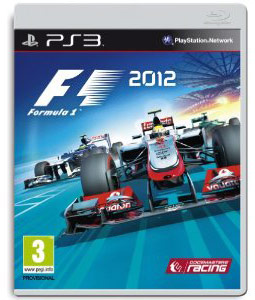 Codemasters is back with a follow-up to its successful – some might go so far as to say genre defining – Formula One franchise, with F1 2012. This season's iteration of the racing title is every bit as beautiful, challenging and engaging to the racing-obsessed gamer as last year's version, though it's far from perfect.
Codemasters is back with a follow-up to its successful – some might go so far as to say genre defining – Formula One franchise, with F1 2012. This season's iteration of the racing title is every bit as beautiful, challenging and engaging to the racing-obsessed gamer as last year's version, though it's far from perfect.
If you can get by the oddly cartoonish and badly cropped image on the front of the box, you'll quickly find that the level of graphical detail in F1 is quite impressive. The cars are clearly the stars of the show here, with every one of the five driving vantage points (ranging from right in the cockpit of the car to a "far chase" position that puts the entire exterior of your vehicle in view) renders the racecar in elegant detail. Reflections and the play of light are evident on the car's bodywork; slick tires are easily differentiated from intermediates and intermediates from full-wets; gravel, grass and dirt all mar the surface of the rear rubber if you go off-track at all; and passing competitor cars are just as vibrant as your own, with high enough frame rates to avoid pixilation or blur.
On the downside, the stuff surrounding your racecar is far less detailed than the machine itself. Each event begins with some flyover shots of the track you're competing on – those higher effort, short cut scenes are fairly nice looking, if still less detailed than the racecars themselves. Pay close attention to the off-track scenery while you're driving, however, and you'll notice that the backgrounds are pretty flat and free of complex surfacing. That's okay, as the overall difficulty of gameplay dictates that you focus on the track, not the grandstands, but it does make the F1 2012 world feel less rich than it might otherwise. One exception to this, though kind of a big one, is the rendering of the sky and the weather seen therein. The Codemasters team has done an exceptional job mimicking the rapidly changing heavens that play such an important part in any real race weekend, with lifelike color and drama, as well as fluid movement.
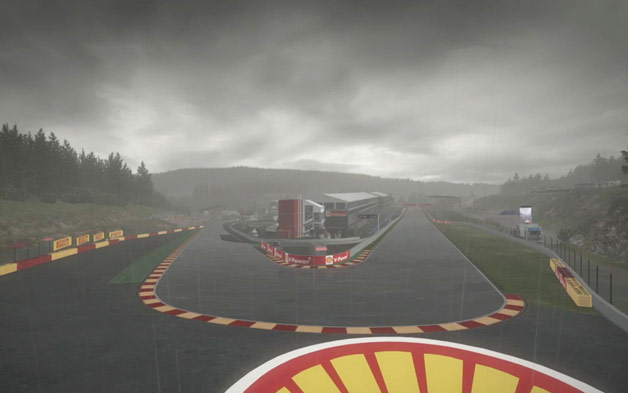
The basic mechanics and navigation of F1 are fairly well done and intuitive to use. The menu screens are all simple to explore, and lovely to look at, with the core non-race menu using large boxed images and a perfectly rendered version of your current ride to add some drama to sorting through settings and game modes. One small but really nice touch is what the game's creators have done with the loading screens for F1. Rather than a static view of a scene or a loading status bar of some kind, F1 presents you with a fast-scrolling feed of statistical info based on your driver profile – average speed overall, number of podiums, driver experience points, etc.

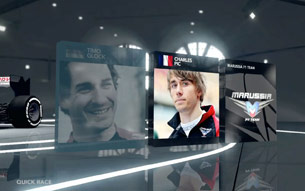
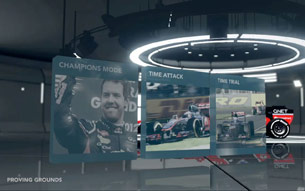
Of course the heart of any driving game, especially one that follows the hyper-reality of F1 2011, is the actual in-car gameplay. After making significant revisions to its physics model, with special attention paid to the activity of the suspension – where there's a lot of differentiation possible between cars and setups – the results are really good. Adjustments made to downforce, balance, fuel load and of course tires are readily noticeable when you hit the circuit. Feedback from different under-tire surfaces – track, curbing, grass, gravel etc. – is easy to pick up on and makes a massive difference in the smoothness and effectiveness on steering inputs.
Lower-level players will also appreciate in-race aids like the Kinetic Energy Recovery System (KERS) and Drag Reduction System (DRS), as well as the franchise's patented "do over" model. KERS and DRS effectively act in a similar manner as "turbo" bonuses in less simulation-based games, as the real-world racing technologies give players an opportunity to have short bursts of extra pace throughout a race. KERS is replenished once per lap in a normal race, while DRS is available to aid in passing when you close within one-second of the car ahead. Better yet for the imprecise is the F1 replay system, which allows you four opportunities within a race to wind back the clock a few seconds, and erase a potentially devastating mistake. In races that go for 15 laps or more, that can be one hell of a relief.
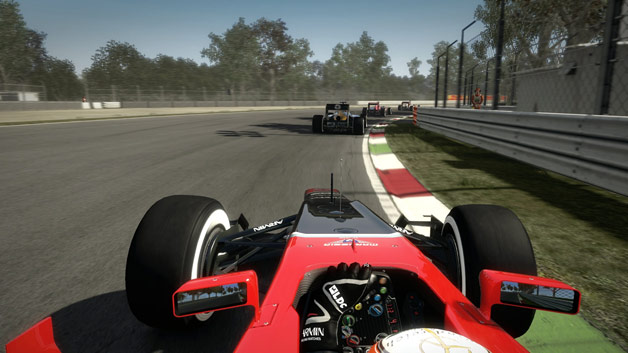
One of the highly touted features for 2012 is the improved system of weather simulation over the course of the full race weekend – practice session, three rounds of qualifying and the race itself. Weather changes rapidly and convincingly in the game, with fronts of rain coming in and affecting, for instance, just one edge of the racetrack at a time, in the early going. It's an impressive thing to watch and deal with, and completely unique in our experience.
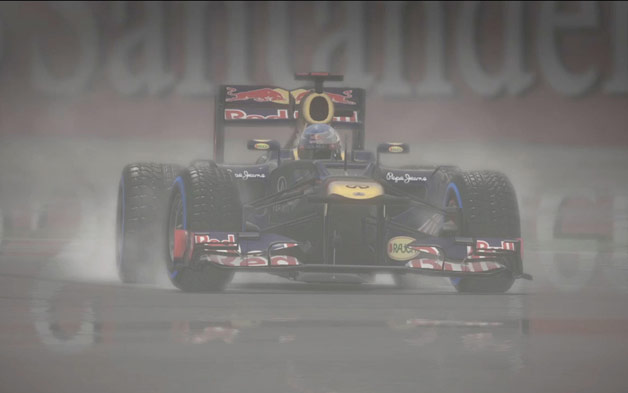
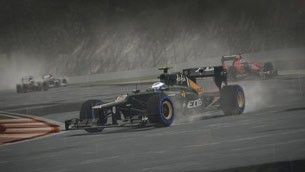
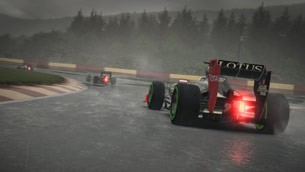
We're also not convinced that the weather in the game is a reflection of the real weather conditions of the race location. Why? Because we suffered a torrential downpour in Bahrain (a country that averages 10 rainy days per year), that's why. The final result is a weather system that feels fully realized in terms of display, but half-baked as far as the game physics are concerned.
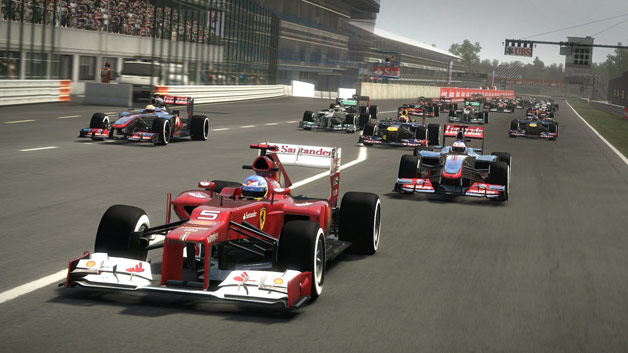
We were also disappointed by other inconsistencies while racing, having mostly to do with game response to driving infractions. There is plenty of bumping and shoving to be found in the crowded start to a race, as well as in passing situations, and if you push an opponent too hard, you'll be flagged for a 10-second time penalty... some of the time. The penalties for causing a crash, cutting a corner or passing during a yellow flag are meted out with a little more randomness than we'd like. In fact, we encountered at least one safety car situation at an especially wet Canadian Grand Prix that lasted for five laps, saw cars "bunching" around the accident site in a completely glitchy fashion and gave us zero penalty for passing many times during yellow-flag, no-passing conditions. We won that race, but those are the sorts of bad-build problems that belong in a past generation of racing titles.
For video-gaming fans of Formula One, F1 2012 is a must-buy title. For those more generally interested in racing and driving games, we'd strongly recommend it, based on our largely positive first impressions. What's more, most of what we didn't enjoy about F1 felt fixable via a large patch or two, so we're hopeful that the racer will be closer to perfect in the coming weeks and months.
 Codemasters is back with a follow-up to its successful – some might go so far as to say genre defining – Formula One franchise, with F1 2012. This season's iteration of the racing title is every bit as beautiful, challenging and engaging to the racing-obsessed gamer as last year's version, though it's far from perfect.
Codemasters is back with a follow-up to its successful – some might go so far as to say genre defining – Formula One franchise, with F1 2012. This season's iteration of the racing title is every bit as beautiful, challenging and engaging to the racing-obsessed gamer as last year's version, though it's far from perfect.
If you can get by the oddly cartoonish and badly cropped image on the front of the box, you'll quickly find that the level of graphical detail in F1 is quite impressive. The cars are clearly the stars of the show here, with every one of the five driving vantage points (ranging from right in the cockpit of the car to a "far chase" position that puts the entire exterior of your vehicle in view) renders the racecar in elegant detail. Reflections and the play of light are evident on the car's bodywork; slick tires are easily differentiated from intermediates and intermediates from full-wets; gravel, grass and dirt all mar the surface of the rear rubber if you go off-track at all; and passing competitor cars are just as vibrant as your own, with high enough frame rates to avoid pixilation or blur.
On the downside, the stuff surrounding your racecar is far less detailed than the machine itself. Each event begins with some flyover shots of the track you're competing on – those higher effort, short cut scenes are fairly nice looking, if still less detailed than the racecars themselves. Pay close attention to the off-track scenery while you're driving, however, and you'll notice that the backgrounds are pretty flat and free of complex surfacing. That's okay, as the overall difficulty of gameplay dictates that you focus on the track, not the grandstands, but it does make the F1 2012 world feel less rich than it might otherwise. One exception to this, though kind of a big one, is the rendering of the sky and the weather seen therein. The Codemasters team has done an exceptional job mimicking the rapidly changing heavens that play such an important part in any real race weekend, with lifelike color and drama, as well as fluid movement.

Another quick note here: the maximum display resolution for F1 is 720p. In a generation of games that is near the very end of the Playstation 3 lifecycle, and for a title that prides itself on visual grandeur, the lack of true 1080p HD is disappointing.The lack of true 1080p HD is disappointing.
The basic mechanics and navigation of F1 are fairly well done and intuitive to use. The menu screens are all simple to explore, and lovely to look at, with the core non-race menu using large boxed images and a perfectly rendered version of your current ride to add some drama to sorting through settings and game modes. One small but really nice touch is what the game's creators have done with the loading screens for F1. Rather than a static view of a scene or a loading status bar of some kind, F1 presents you with a fast-scrolling feed of statistical info based on your driver profile – average speed overall, number of podiums, driver experience points, etc.



Of course the heart of any driving game, especially one that follows the hyper-reality of F1 2011, is the actual in-car gameplay. After making significant revisions to its physics model, with special attention paid to the activity of the suspension – where there's a lot of differentiation possible between cars and setups – the results are really good. Adjustments made to downforce, balance, fuel load and of course tires are readily noticeable when you hit the circuit. Feedback from different under-tire surfaces – track, curbing, grass, gravel etc. – is easy to pick up on and makes a massive difference in the smoothness and effectiveness on steering inputs.
Gamers just getting involved in the F1 franchise will be happy to hear that the game's easiest settings make it simple to just pick up a controller and play. Codemasters has thoughtfully included a "brake assist" setting that, in concert with a 3D representation of the correct racing line (which can be shut off, of course), allows a novice to be competent, if not competitive, right off the bat. The very good Young Drivers Test mode – essentially a long-form tutorial – adds to this coziness for new players, using a mix of controls primers and video instructions to make one feel at home behind the virtual wheel. Complete your training, which takes about 45 minutes, and you should be ready to jump into one of the more involved gameplay modes.The game's easiest settings make it simple to just pick up a controller and play.
Lower-level players will also appreciate in-race aids like the Kinetic Energy Recovery System (KERS) and Drag Reduction System (DRS), as well as the franchise's patented "do over" model. KERS and DRS effectively act in a similar manner as "turbo" bonuses in less simulation-based games, as the real-world racing technologies give players an opportunity to have short bursts of extra pace throughout a race. KERS is replenished once per lap in a normal race, while DRS is available to aid in passing when you close within one-second of the car ahead. Better yet for the imprecise is the F1 replay system, which allows you four opportunities within a race to wind back the clock a few seconds, and erase a potentially devastating mistake. In races that go for 15 laps or more, that can be one hell of a relief.

Of course, the level of difficulty quickly becomes pretty brutal as you opt into the more advanced settings. Specifically, steering and braking inputs require such a deft hand and such precision, that it's all but impossible to get the job done with a standard issue PS3 Sixaxis controller. The really dedicated racing gamers will absolutely want a wheel/pedal setup to be competitive at the highest levels of difficulty in F1. This was true of last year's version of the franchise, as well, though that title didn't offer much recourse for the beginner. As a game for the full-spectrum of PS3 users then, F1 2012 is a massive step forward.Dedicated racing gamers will absolutely want a wheel/pedal setup to be competitive at the highest levels of difficulty.
One of the highly touted features for 2012 is the improved system of weather simulation over the course of the full race weekend – practice session, three rounds of qualifying and the race itself. Weather changes rapidly and convincingly in the game, with fronts of rain coming in and affecting, for instance, just one edge of the racetrack at a time, in the early going. It's an impressive thing to watch and deal with, and completely unique in our experience.



On the downside, the rain conditions don't actually interact with the track surface as fluidly in gameplay as they do graphically. Said another way, you'll see the rain long before you start to feel it. In some respects that's okay; in real life a few raindrops don't instantly change the dynamics of the track. But we experienced races where rain was visible for several laps before our virtual pit crew called out a warning to us (and even then we were often told that rain was "coming" when it was already evidenced), with still more of a delay before the racing surface started to feel at all slick.We suffered a torrential downpour in Bahrain (a country that averages 10 rainy days per year).
We're also not convinced that the weather in the game is a reflection of the real weather conditions of the race location. Why? Because we suffered a torrential downpour in Bahrain (a country that averages 10 rainy days per year), that's why. The final result is a weather system that feels fully realized in terms of display, but half-baked as far as the game physics are concerned.

We were also disappointed by other inconsistencies while racing, having mostly to do with game response to driving infractions. There is plenty of bumping and shoving to be found in the crowded start to a race, as well as in passing situations, and if you push an opponent too hard, you'll be flagged for a 10-second time penalty... some of the time. The penalties for causing a crash, cutting a corner or passing during a yellow flag are meted out with a little more randomness than we'd like. In fact, we encountered at least one safety car situation at an especially wet Canadian Grand Prix that lasted for five laps, saw cars "bunching" around the accident site in a completely glitchy fashion and gave us zero penalty for passing many times during yellow-flag, no-passing conditions. We won that race, but those are the sorts of bad-build problems that belong in a past generation of racing titles.
In all though, this is a truly fun, well-constructed racing title. Our early experience with F1 2012 didn't allow us any real experience with online racing (we'll try to do an update when there's a bit more of a user base), but the rest of the game modes are compelling and enjoyable, by and large. The heart of the title is still in the Career Mode, as far as we're concerned, but the ability to play on a smaller scale with the entertaining Proving Grounds and Season Challenge modes, offer a high level of replayability, too.Most of what we didn't enjoy about F1 felt fixable via a large patch or two.
For video-gaming fans of Formula One, F1 2012 is a must-buy title. For those more generally interested in racing and driving games, we'd strongly recommend it, based on our largely positive first impressions. What's more, most of what we didn't enjoy about F1 felt fixable via a large patch or two, so we're hopeful that the racer will be closer to perfect in the coming weeks and months.

Sign in to post
Please sign in to leave a comment.
Continue